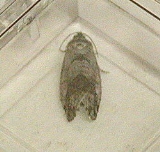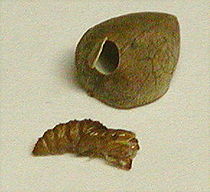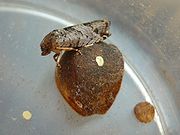
Cydia deshaisiana
Encyclopedia


Mexico
The United Mexican States , commonly known as Mexico , is a federal constitutional republic in North America. It is bordered on the north by the United States; on the south and west by the Pacific Ocean; on the southeast by Guatemala, Belize, and the Caribbean Sea; and on the east by the Gulf of...
that is most widely known as its larva, where it inhabits the carpels of seeds from several species of the shrub genus Sebastiania
Sebastiania
Sebastiania is a plant genus in the Euphorbiaceae family, comprising about 100 species. These are shrubs found in tropical and warm areas.Species include:*Sebastiania alpina*Sebastiania crenulata*Sebastiania fasciculata...
(S. pavoniana or S. palmeri). These seeds are commonly known as Mexican jumping beans.
The moth lays the egg on the young pod. The hatched larva gnaws into the seed, which closes the minute hole during its growth.
The larva attaches itself to the bean with many silk
Silk
Silk is a natural protein fiber, some forms of which can be woven into textiles. The best-known type of silk is obtained from the cocoons of the larvae of the mulberry silkworm Bombyx mori reared in captivity...
en threads by hooks on its anal and four hind abdominal prolegs. When the bean is abruptly warmed, for instance by being held in the palm of the hand, the larva twitches and spasms, pulling on the threads and causing the characteristic hop. "Jump" is often an exaggeration, but the beans nonetheless do move around quite a bit.
The larva may live for months inside the bean with varying periods of dormancy.
It eats away the inside of the bean, making a hollow for itself. If the seed is cut, the larva will repair the hole with silk.
If the larva has adequate conditions such as moisture, it will live long enough to go into a pupal stage.
In preparation to this, it eats a circular hole through the shell in February and closes it again with a silken plug. This is to enable the jawless adult moth to escape from the seed. After completion of the exit hole it spins a cocoon within the seed, with a passage way leading to the door. During the following pupal stage the larva will not move any more.
Normally in the spring, the moth will force its way out of the bean through a round "trap door", leaving behind the pupal casing.
The small, jawless silver and gray-colored moth will live for only a few days.
Synonyms
Commonly used synonyms for the species are Carpocapsa saltitans or Laspeyresia saltitans — carpo indicating that it lives within a seed (see podocarp), and saltitans referring to its jumping behavior.See also
- Emporia melanobasis, a moth with similar habits, parasitizing in Spirostachys africanaSpirostachys africanaSpirostachys africana is a medium-sized deciduous tree with a straight, clear trunk, occurring in the warmer parts of Southern Africa...
. - Nanodes tamarisci, acting similarly in the seed of TamarixTamarixThe genus Tamarix is composed of about 50-60 species of flowering plants in the family Tamaricaceae, native to drier areas of Eurasia and Africa...
. - the gall waspGall waspGall wasps , also called Gallflies, are a family of the order Hymenoptera and are classified with the Apocrita suborder of wasps in the superfamily Cynipoidea...
Neuroterus saltatorius shows similar behavior in gallGallGalls or cecidia are outgrowths on the surface of lifeforms caused by invasion by other lifeforms, such as parasites or bacterial infection. Plant galls are abnormal outgrowths of plant tissues and can be caused by various parasites, from fungi and bacteria, to insects and mites...
s produced in several oakOakAn oak is a tree or shrub in the genus Quercus , of which about 600 species exist. "Oak" may also appear in the names of species in related genera, notably Lithocarpus...
species, although during the pupal state.http://waynesword.palomar.edu/pldec97.htm

